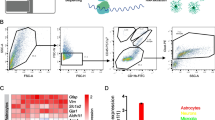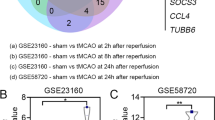Abstract
Bradykinin (BK) is a proinflammatory mediator and elevated in several brain injury and inflammatory diseases. The deleterious effects of BK on brain astrocytes may aggravate brain inflammation mediated through the upregulation of cytosolic phospholipase A2 (cPLA2)/cyclooxygenase-2 (COX-2)-derived prostaglandin E2 (PGE2) production. However, the signaling mechanisms underlying BK-induced cPLA2 expression in brain astrocytes remain unclear. Herein, we investigated the effects of activation of cPLA2/COX-2 system on BK-induced cPLA2 upregulation in rat brain astrocytes (RBA-1). The data obtained with Western blotting, RT-PCR, and immunofluorescent staining analyses showed that BK-induced de novo cPLA2 expression was mediated through activation of cPLA2/COX-2 system. Upregulation of native cPLA2/COX-2 system by BK through activation of PKCδ, c-Src, MAPKs (ERK1/2 and JNK1/2) cascades led to PGE2 biosynthesis and release. Subsequently, the released PGE2 induced cPLA2 expression via the same signaling pathways (PKCδ, c-Src, ERK1/2, and JNK1/2) and then activated the cyclic AMP response element-binding protein (CREB) via B2 BK receptor-mediated cPLA2/COX-2 system-derived PGE2/EP-dependent manner. Finally, upregulation of cPLA2 by BK may promote more PGE2 production. These results demonstrated that in RBA-1, activation of CREB by PGE2/EP-mediated PKCδ/c-Src/MAPK cascades is essential for BK-induced de novo cPLA2 protein. More importantly, upregulation of cPLA2 by BK through native cPLA2/COX-2 system may be a positive feedback mechanism that enhances prolonged brain inflammatory responses. Understanding the mechanisms of cPLA2/COX-2 system upregulated by BK on brain astrocytes may provide rational therapeutic interventions for brain injury and inflammatory diseases.








Similar content being viewed by others
References
Yedgar S, Lichtenberg D, Schnitzer E (2000) Inhibition of phospholipase A2 as a therapeutic target. Biochim Biophys Acta 1488:182–187
Murakami M, Kudo I (2002) Phospholipase A2. J Biochem 131:285–292
Farooqui AA, Horrocks LA (2004) Brain phospholipases A2: a perspective on the history. Prostaglandins Leukot Essent Fatty Acids 71:161–169
Hernández M, Nieto ML, Sánchez Crespo M (2000) Cytosolic phospholipase A2 and the distinct transcriptional programs of astrocytoma cells. Trends Neurosci 23:259–264
Niknami M, Patel M, Witting PK, Dong Q (2009) Molecules in focus: cytosolic phospholipase A2α. Int J Biochem Cell Biol 41:994–997
Leslie CC (1997) Properties and regulation of cytosolic phospholipase A2. J Biol Chem 272:16709–16712
Kishimoto K, Matsumura K, Kataoka Y, Morii H, Watanabe Y (1999) Localization of cytosolic phospholipase A2 messenger RNA mainly in neurons in the rat brain. Neuroscience 92:1061–1077
Stephenson DT, Manetta JV, White DL, Chiou XG, Cox L, Gitter B, May PC, Sharp JD, Kramer RM, Clemens JA (1994) Calcium-sensitive cytosolic phospholipase A2 (cPLA2) is expressed in human brain. Brain Res 637:97–105
Sun GY, Xu J, Jensen MD, Yu S, Wood WG, González FA, Simonyi A, Sun AY, Weisman GA (2005) Phospholipase A2 in astrocytes: responses to oxidative stress, inflammation, and G protein-coupled receptor agonists. Mol Neurobiol 31:27–41
Stephenson D, Rash K, Smalstig B, Roberts E, Johnstone E, Sharp J, Panetta J, Little S, Kramer R, Clemens J (1999) Cytosolic phospholipase A2 is induced in reactive glia following different forms of neurodegeneration. Glia 27:110–128
Gentile MT, Reccia MG, Sorrentino PP, Vitale E, Sorrentino G, Puca AA, Colucci-D'Amato L (2012) Role of cytosolic calcium-dependent phospholipase A2 in Alzheimer's disease pathogenesis. Mol Neurobiol 45:596–604
Balboa MA, Varela-Nieto I, Lucas KK, Dennis EA (2002) Expression and function of phospholipase A2 in brain. FEBS Lett 531:12–17
Xu J, Chalimoniuk M, Shu Y, Simonyi A, Sun AY, Gonzalez FA, Weisman GA, Wood WG, Sun GY (2003) Prostaglandin E2 production in astrocytes: regulation by cytokines, extracellular ATP, and oxidative agents. Prostaglandins Leukot Essent Fatty Acids 69:437–448
Levinson SW, Goldman JE (1993) Astrocyte origins. In: Murphy S (ed) Astrocytes: pharmacology and function. Academic, San Diego, pp 1–22
Kimelberg HK (1995) Receptors on astrocytes—what possible functions? Neurochem Int 26:27–40
Eng LF, Ghirnikar RS (1994) GFAP and astrogliosis. Brain Pathol 4:229–237
Ridet JL, Malhotra SK, Privat A, Gage FH (1997) Reactive astrocytes: cellular and molecular cues to biological function. Trends Neurosci 20:570–577
Ellis EF, Chao J, Heizer ML (1989) Brain kininogen following experimental brain injury: evidence for a secondary event. J Neurosurg 71:437–442
Schwaninger M, Sallmann S, Petersen N, Schneider A, Prinz S, Libermann TA, Spranger M (1999) Bradykinin induces interleukin-6 expression in astrocytes through activation of nuclear factor-κB. J Neurochem 73:1461–1466
Richardson JD, Vasko MR (2002) Cellular mechanisms of neurogenic inflammation. J Pharmacol Exp Ther 302:839–845
Hsieh HL, Yen MH, Jou MJ, Yang CM (2004) Intracellular signalings underlying bradykinin-induced matrix metalloproteinase-9 expression in rat brain astrocyte-1. Cell Signal 16:1163–1176
Hsieh HL, Wu CY, Hwang TL, Yen MH, Parker P, Yang CM (2006) BK-induced cytosolic phospholipase A2 expression via sequential PKC-δ, p42/p44 MAPK, and NF-κB activation in rat brain astrocytes. J Cell Physiol 206:246–254
Bhoola K, Figueroa C, Worthy K (1992) Bioregulation of kinins: kallikreins, kininogens, and kininases. Pharmacol Rev 44:1–80
Nishizuka Y (1992) Intracellular signaling by hydrolysis of phospholipids and activation of protein kinase C. Science 258:607–614
Chen CC, Chang J, Chen WC (1995) Role of protein kinase C subtypes α and δ in the regulation of bradykinin-stimulated phosphoinositide breakdown in astrocytes. Mol Pharmacol 48:39–47
Cobb MH, Goldsmith EJ (1995) How MAP kinases are regulated. J Biol Chem 270:14843–14846
Pyne NJ, Tolan D, Pyne S (1997) Bradykinin stimulates cAMP synthesis via mitogen-activated protein kinase-dependent regulation of cytosolic phospholipase A2 and prostaglandin E2 release in airway smooth muscle. Biochem J 328:689–694
Xing M, Tao L, Insel PA (1997) Role of extracellular signal-regulated kinase and PKCα in cytosolic PLA2 activation by bradykinin in MDCK-D1 cells. Am J Physiol 272:C1380–C1387
Xu J, Weng YI, Simonyi A, Krugh BW, Liao Z, Weisman GA, Sun GY, Simoni A (2002) Role of PKC and MAPK in cytosolic PLA2 phosphorylation and arachidonic acid release in primary murine astrocytes. J Neurochem 83:259–270
Hai CM (2007) Airway smooth muscle cell as therapeutic target of inflammation. Curr Med Chem 14:67–76
Rosethorne EM, Nahorski SR, Challiss RA (2008) Regulation of cyclic AMP response-element binding-protein (CREB) by Gq/11-protein-coupled receptors in human SH-SY5Y neuroblastoma cells. Biochem Pharmacol 75:942–955
Hazan-Eitan Z, Weinstein Y, Hadad N, Konforty A, Levy R (2006) Induction of FcγRIIA expression in myeloid PLB cells during differentiation depends on cytosolic phospholipase A2 activity and is regulated via activation of CREB by PGE2. Blood 108:1758–1766
Guo C, Li J, Myatt L, Zhu X, Sun K (2010) Induction of Gαs contributes to the paradoxical stimulation of cytosolic phospholipase A2α expression by cortisol in human amnion fibroblasts. Mol Endocrinol 24:1052–1061
Tay A, Maxwell P, Li Z, Goldberg H, Skorecki K (1994) Isolation of promoter for cytosolic phospholipase A2 (cPLA2). Biochim Biophys Acta 1217:345–347
Shi J, Wang Q, Johansson JU, Liang X, Woodling NS, Priyam P, Loui TM, Merchant M, Breyer RM, Montine TJ, Andreasson K (2012) Inflammatory prostaglandin E2 signaling in a mouse model of Alzheimer disease. Ann Neurol 72:788–798
Mukherjee AB (1990) PLA2 central role in inflammation. In: Mukherjee AB (ed) Biochemistry, molecular biology and physiology of phospholipase A2 and its regulatory factors. Plenum, New York and London, pp 52–60
Sanchez-Mejia RO, Newman JW, Toh S, Yu GQ, Zhou Y, Halabisky B, Cissé M, Scearce-Levie K, Cheng IH, Gan L, Palop JJ, Bonventre JV, Mucke L (2008) Phospholipase A2 reduction ameliorates cognitive deficits in a mouse model of Alzheimer's disease. Nat Neurosci 11:1311–1318
Murakami M, Kambe T, Shimbara S, Kudo I (1999) Functional coupling between various phospholipase A2s and cyclooxygenases in immediate and delayed prostanoid biosynthetic pathways. J Biol Chem 274:3103–3115
Bosetti F, Weerasinghe GR (2003) The expression of brain cyclooxygenase-2 is down-regulated in the cytosolic phospholipase A2 knockout mouse. J Neurochem 87:1471–1477
Lin CC, Lin WN, Wang WJ, Sun CC, Tung WH, Wang HH, Yang CM (2009) Functional coupling expression of COX-2 and cPLA2 induced by ATP in rat vascular smooth muscle cells: role of ERK1/2, p38 MAPK, and NF-κB. Cardiovasc Res 82:522–531
Walker K, Perkins M, Dray A (1995) Kinins and kinin receptors in the nervous system. Neurochem Int 26:1–16
de Carvalho MG, McCormack AL, Olson E, Ghomashchi F, Gelb MH, Yates JR 3rd, Leslie CC (1996) Identification of phosphorylation sites of human 85-kDa cytosolic phospholipase A2 expressed in insect cells and present in human monocytes. J Biol Chem 271:6987–6997
Hirabayashi T, Murayama T, Shimizu T (2004) Regulatory mechanism and physiological role of cytosolic phospholipase A2. Biol Pharm Bull 27:1168–1173
Börsch-Haubold AG, Bartoli F, Asselin J, Dudler T, Kramer RM, Apitz-Castro R, Watson SP, Gelb MH (1998) Identification of the phosphorylation sites of cytosolic phospholipaseA2 in agonist-stimulated human platelets and HeLa cells. J Biol Chem 273:4449–4458
Lin LL, Wartmann M, Lin AY, Knopf JL, Seth A, Davis RJ (1993) cPLA2 is phosphorylated and activated by MAP kinase. Cell 72:269–278
Kaminska B, Gozdz A, Zawadzka M, Ellert-Miklaszewska A, Lipko M (2009) MAPK signal transduction underlying brain inflammation and gliosis as therapeutic target. Anat Rec (Hoboken) 292:1902–1913
Matsuzawa Y, Kiuchi Y, Toyomura K, Matsumoto I, Nakamura H, Fujino H, Murayama T, Kawashima T (2009) Activation of cytosolic phospholipase A2α by epidermal growth factor (EGF) and phorbol ester in HeLa cells: different effects of inhibitors for EGF receptor, protein kinase C, Src, and C-Raf. J Pharmacol Sci 111:182–192
Zhang Q, Wang D, Singh NK, Kundumani-Sridharan V, Gadiparthi L, Rao CM, Rao GN (2011) Activation of cytosolic phospholipase A2 downstream of the Src-phospholipase D1 (PLD1)-protein kinase C γ (PKCγ) signaling axis is required for hypoxia-induced pathological retinal angiogenesis. J Biol Chem 286:22489–22498
Loos B, Smith R, Engelbrecht AM (2008) Ischaemic preconditioning and TNF-α-mediated preconditioning is associated with a differential cPLA2 translocation pattern in early ischaemia. Prostaglandins Leukot Essent Fatty Acids 78:403–413
Sun GY, Shelat PB, Jensen MB, He Y, Sun AY, Simonyi A (2010) Phospholipases A2 and inflammatory responses in the central nervous system. Neuromolecular Med 12:133–148
Josselyn SA, Nguyen PV (2005) CREB, synapses and memory disorders: past progress and future challenges. Curr Drug Targets CNS Neurol Disord 4:481–497
Kitagawa K (2007) CREB and cAMP response element-mediated gene expression in the ischemic brain. FEBS J 274:3210–3217
Szaingurten-Solodkin I, Hadad N, Levy R (2009) Regulatory role of cytosolic phospholipase A2α in NADPH oxidase activity and in inducible nitric oxide synthase induction by aggregated Aβ1–42 in microglia. Glia 57:1727–1740
Acknowledgments
This work was supported by the National Science Council, Taiwan; Grant numbers: NSC102-2321-B-182-011, NSC101-2320-B-182-039-MY3, NSC101-2314-B-182-182A-112, and NSC102-2320-B-255-005-MY3; the Chang Gung Medical Research Foundation, Grant numbers: CMRPD1C0102, CMRPD1B0383, CMRPD1C0562, CMRPG3B1093, CMRPG3C1302, CMRPD1B0331, CMRPG5C0061, CMRPF1C0191, and CMRPF1A0063; and the Ministry of Education, Taiwan; Grant numbers: EMRPD1D0231 and EMRPD1D0241.
Conflict of Interest
None.
Author information
Authors and Affiliations
Corresponding author
Additional information
Chih-Chung Lin and Hsi-Lung Hsieh are equal contributors.
Rights and permissions
About this article
Cite this article
Lin, CC., Hsieh, HL., Liu, SW. et al. BK Induces cPLA2 Expression via an Autocrine Loop Involving COX-2-Derived PGE2 in Rat Brain Astrocytes. Mol Neurobiol 51, 1103–1115 (2015). https://doi.org/10.1007/s12035-014-8777-7
Received:
Accepted:
Published:
Issue Date:
DOI: https://doi.org/10.1007/s12035-014-8777-7




